|
As the final resting place for thousands of people, the numerous cemeteries in Kalaupapa chronicle the lives of those people who lived in the settlement and experienced both joy and suffering. Cemeteries and individual grave markers serve as the tangible link between past and present, serving as touchstones for human emotions, realities of death, and lost loved ones for many Hawaiian families. But for our larger society, the graves at Kalaupapa, marked and unmarked, remind us of the human price paid for the Hansen's disease isolation policies. Today, Kalaupapa National Historical Park contains approximately 1200 grave markers and several hundred unmarked graves in over 15 cemeteries. Graves are largely concentrated in four main areas—Papaloa Cemetery, Kahaloko Cemetery, Kauhakō Crater, and Moku Puakala. 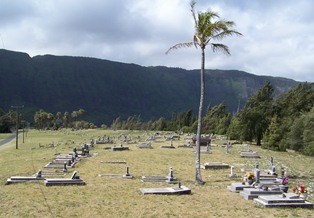
Papaloa CemeteryPapaloa Cemetery (meaning long, flat area) is a compilation of 12 burial areas at the west edge of the peninsula immediately adjacent to the shoreline and beaches. Each area is separated by the religious and cultural affiliations of Kalaupapa's residents. Catholic, Protestant, Mormon, Chinese, Americans of Japanese Ancestry, and Hawaiian sections of the cemetery are clearly delineated by groupings of grave markers with Hawaiian, Chinese, Japanese and English inscriptions. In the early 20th century, rock walls were built around some of the earlier sections of the cemetery; however, a large number of grave markers and walls in the Papaloa Cemetery were destroyed by a tsunami in 1946. By the mid-20th century, fences were built around the cemetery to prevent cattle from damaging graves. Today, Papaloa continues to be an active burial ground. There are several types of grave markers that reveal the changing tastes and styles from the late 19th century to the early 2000s. Many of the more recent graves have draped na lei, plastic flower bunches, and other mementos. 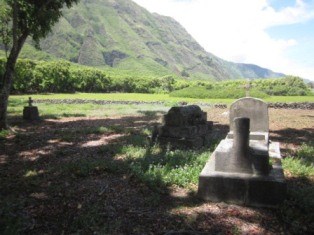
Kahaloko CemeteryKahaloko Cemetery is located within the Makanalua Ahupua`a (land division) along Damien Road. Containing marked graves dating from 1887 to 1921, the cemetery may also have earlier pre-contact graves that are marked with stacked piles of rocks. The entire cemetery is enclosed with a traditional Hawaiian-style, dry-stacked rock wall. Until recently, the existence of Kahaloko Cemetery had largely been forgotten, and overgrown with vegetation. The National Park Service, in partnership with several volunteer groups, has cleared large areas of vegetation to make the cemetery visible from the nearby road. Today, the cemetery is a quiet place of tranquility with shady areas to reflect under large trees. 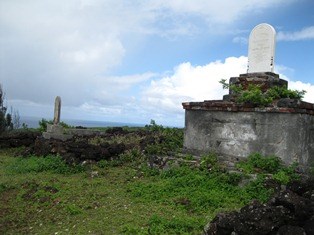
Kauhako CraterGrave sites at Kauhakō Crater are located at the west edge of the crater rim, overlooking the crater to the east and the Kalaupapa Settlement and ocean to the west. The crater area contains several grave markers grouped together and surrounded by dry-laid rock walls, as well as other scattered individual markers. The graves at Kauhakō Crater are thought to be associated with the Church of Jesus Christ of Latter Day Saints at the turn of the century. 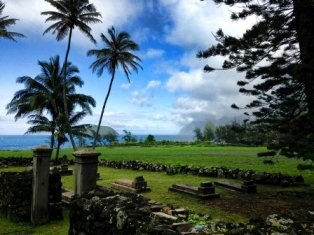
Moku PuakalaOn the east side of the peninsula at Kalawao, cemeteries are associated with the two historic churches, Siloama Congregational Church and St. Philomena Catholic Church. Moku Puakala is a concentration of marked and unmarked graves near St. Philomena Church at Kalawao. This area immediately adjacent to St. Philomena contains the graves of Father Damien (which contains a relic of his right hand) and Brother Joseph Dutton, and several other religious workers who served at the Baldwin Home at Kalawao. Beyond the church to the east are two large fields with only a few marked graves. However, these fields are believed to contain thousands of burials. The markers are long lost, but the inherent power of these fields is felt in remembrance of the people sent into isolation to live and die at Kalawao. In a January 31, 1880 letter to his brother, Father Damien De Veuster wrote, "Since I have been here, I have buried from one hundred and ninety to two hundred every year, and still the number of living lepers is always over seven hundred... There are many empty places in the church, but in the cemetery, there is hardly room left to dig the graves." 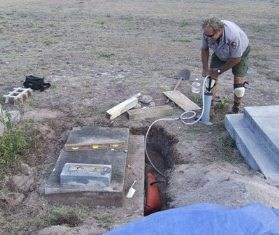
Grave Marker Preservation ProgramToday, the cemeteries and grave markers throughout the park are being restored and brought back from neglect and disrepair. Weather, salt water, natural disaster, invasive vegetation, and limited maintenance over the past decades have taken their toll on these reminders of the past. However, in 2008, the park began a recurring cyclic program for the preservation of grave markers, where markers are prioritized each year based on the level of deterioration, immediate threat, and available funds. Since the hands-on program began, approximately 140 grave markers have received preservation treatment. The grave marker preservation program preserves the memory of past residents, honors the remaining living patients, and educates park visitors about this sacred aspect of Kalaupapa history. The preservation of grave markers is also important in reconnecting individuals to their family history through genealogical research inquiries. Gravestones are family records that record names, birth and death dates, and epitaphs that reflect the lives and personalities of people who lived in the past. Cemetery preservation at the park continues to reconnect families to their past, honor family lines, and better understand Kalaupapa's history. |
Last updated: December 14, 2022
